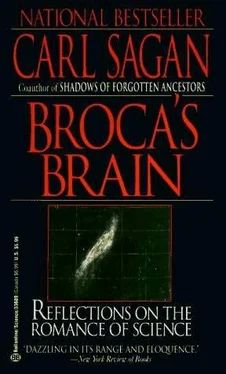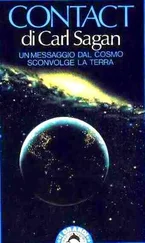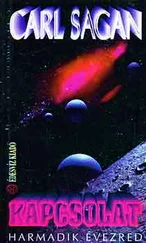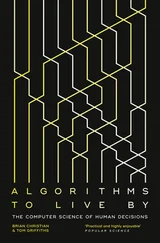The best antidote for pseudoscience, I firmly believe, is science:

There is an African fresh-water fish that is blind. It generates a standing electric field, through perturbations in which it distinguishes between predators and prey and communicates in a fairly elaborate electrical language with potential mates and other fish of the same species. This involves an entire organ system and sensory capability completely unknown to pretechnological human beings.

There is a kind of arithmetic, perfectly reasonable and self-contained, in which two times one does not equal one times two.

Pigeons-one of the least prepossessing animals on Earth-are now found to have a remarkable sensitivity to magnetic-field strengths as small as one hundred thousandth that of the Earth’s magnetic dipole. Pigeons evidently use this sensory capability for navigation and sense their surroundings by their magnetic signatures: metal gutters, electrical power lines, fire escapes and the like-a sensory modality glimpsed by no human being who ever lived.

Quasars seem to be explosions of almost unimaginable violence in the hearts of galaxies which destroy millions of worlds, many of them perhaps inhabited.

In an East African volcanic ash flow 3.5 million years old there are footprints-of a being about four feet high with a purposeful stride that may be the common ancestor of apes and men. Nearby are the prints of a knuckle-walking primate corresponding to no animal yet discovered.

Each of our cells contains dozens of tiny factories called mitochondria which combine our food with molecular oxygen in order to extract energy in convenient form. Recent evidence suggests that billions of years ago the mitochondria were free organisms which have slowly evolved into a mutually dependent relation with the cell. When many-celled organisms arose, the arrangement was retained. In a very real sense, then, we are not a single organism, but an array of about ten trillion beings and not all of the same kind.

Mars has a volcano almost 80,000 feet high which was constructed about a billion years ago. An even larger volcano may exist on Venus.

Radio telescopes have detected the cosmic black-body background radiation, the distant echo of the event called the Big Bang. The fires of creation are being observed today.
I could continue such a list almost indefinitely. I believe that even a smattering of such findings in modern science and mathematics is far more compelling and exciting than most of the doctrines of pseudoscience, whose practitioners were condemned as early as the fifth century B.C. by the Ionian philosopher Heraclitus as “night-walkers, magicians, priests of Bacchus, priestesses of the wine-vat, mystery-mongers.” But science is more intricate and subtle, reveals a much richer universe, and powerfully evokes our sense of wonder. And it has the additional and important virtue-to whatever extent the word has any meaning-of being true.
WHITE DWARFS AND LITTLE GREEN MEN

No testimony is sufficient to establish a miracle,
unless… its falsehood would be more
miraculous than the fact
which it endeavors to establish.
DAVID HUME,
Of Miracles
HUMANITY HAS already achieved interstellar spaceflight. With a gravitational assist from the planet Jupiter, the Pioneer 10 and 11 and the Voyager 1 and 2 spacecraft have been boosted into trajectories that will leave the solar system for the realm of the stars. They are very slow-moving spacecraft despite the fact that they are the fastest objects ever launched by our species. They will take tens of thousands of years to travel typical interstellar distances. Unless some special effort is made to redirect them, they will never enter another planetary system in all the tens of billions of years of future history of the Milky Way Galaxy. The star-to-star distances are too large. They are doomed to wander forever in the dark between the stars. But even so, these spacecraft have messages attached to them for the remote contingency that at some future time, alien beings might intercept the spacecraft and wonder about the beings who launched them on these prodigious journeys. [3]
If we are capable of such constructions at our comparatively backward technological state, might not a civilization thousands or millions of years more advanced than ours, on a planet of another star, be capable of fast and directed interstellar travel? Interstellar spaceflight is time-consuming, difficult and expensive for us, and perhaps also for other civilizations with substantially greater resources than ours. But it surely would be unwise to contend that conceptually novel approaches to the physics or engineering of interstellar spaceflight will not be discovered by us sometime in the future. It is evident that for economy, efficiency and convenience, interstellar radio transmission is much superior to interstellar spaceflight, and this is the reason that our own efforts have concentrated strongly on radio communication. But radio communication is clearly inappropriate for contact with a pretechnological society or species. No matter how clever or powerful the transmission, no such radio message would have been received or understood on Earth before the present century. And there has been life on our planet for about four billion years, human beings for several million, and civilization for perhaps ten thousand.
It is not inconceivable that there is a kind of Galactic Survey, established by cooperating civilizations on many planets throughout the Milky Way Galaxy, which keeps an eye (or some equivalent organ) on emerging planets and seeks out undiscovered worlds. But the solar system is very far from the center of the Galaxy and could well have eluded such searches. Or survey ships may come here, but only every ten million years, say-with none having arrived during historical times. However, it is also possible that a few survey teams have arrived recently enough in human history for their presence to have been noted by our ancestors, or even for human history to have been affected by the contact.
The Soviet astrophysicist I. S. Shklovskii and I discussed this possibility in our book, Intelligent Life in the Universe , in 1966. We examined a range of artifacts, legends and folklore from many cultures and concluded that not one of these cases provided even moderately convincing evidence for extraterrestrial contact. There are always more plausible alternative explanations based on known human abilities and behavior. Among the cases discussed were a number later accepted by Erich von Däniken and other uncritical writers as valid evidence for extraterrestrial contact: Sumerian legends and astronomical cylinder seals; the Biblical stories of the Slavonic Enoch and of Sodom and Gomorrah; the Tassili frescoes in North Africa; the machined metal cube allegedly found in ancient geological sediments and said to be displayed in a museum in Austria; and so on. Over the years I have continued to look as deeply as I am able into such stories and have found very few that require more than passing attention.
Читать дальше




















